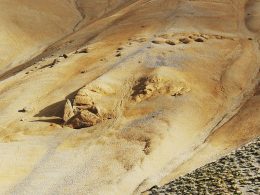For the first time in a long time, a musician blew into a conch shell that is about 18,000 years old to create a musical tune. The shell has been at the National Center for Scientific Research after it was discovered in a cave filled with painting and other objects dating back to the same period. Researchers said the Marsoulas Cave, where the conch shell was found, contained a part of the history of people who must have been nomadic hunters.
The researchers said they were not very sure that the shell could take much strain, and they did not want to damage such an antique, so they asked the musician to play only for some seconds. The musician was able to play three distinct notes which sound very similar to what we know as the C, C-sharp, and D musical notes. The recording accompanied a larger study published in the journal Science Advances.
The scientists said they wanted to establish what its original users did with it and how long it has been around. To ascertain the age of the shell, the researchers said they had to do a little carbon dating, they also discovered that the original users had modified it to serve as some sort of musical or communication instrument. On the conical end of the shell lies a 1.4 inches opening, that the scientists said was deliberately made, as the tip of the shell is very hard, CNN reports.
The original users of the shell must have cut and drilled the tip, and its side so that they can blow into the shell. It was also painted with hematite, a substance with a reddish color. Those that worked on the study said the substance was also used in creating the paintings that were also found with the shell. The researchers think that the shell must have been used with a mouthpiece, just like other shells discovered in different parts of the world.
One of the people that worked on the study, Gilles Tosello of the University of Toulouse, told reporters that the users of the conch shell definitely used it to make sounds but that does not necessarily mean it was a musical instrument. Tosello opined that it might have been used to communicate or perform rituals.
The researchers said they arrived at the conclusion that the original users were wanderers because materials with similar compositions were discovered in caves in the northern part of Spain. The researchers said the original owners of the materials must have journeyed between the region of the Pyrenees and the Atlantic Coast. Tosello stated that the journeys were done to hunt for food.
Tosello and his colleagues will work on creating a 3D image of the age-old shell; they will also examine the distance at which sounds from the shell can be heard.
Source: npr.org








